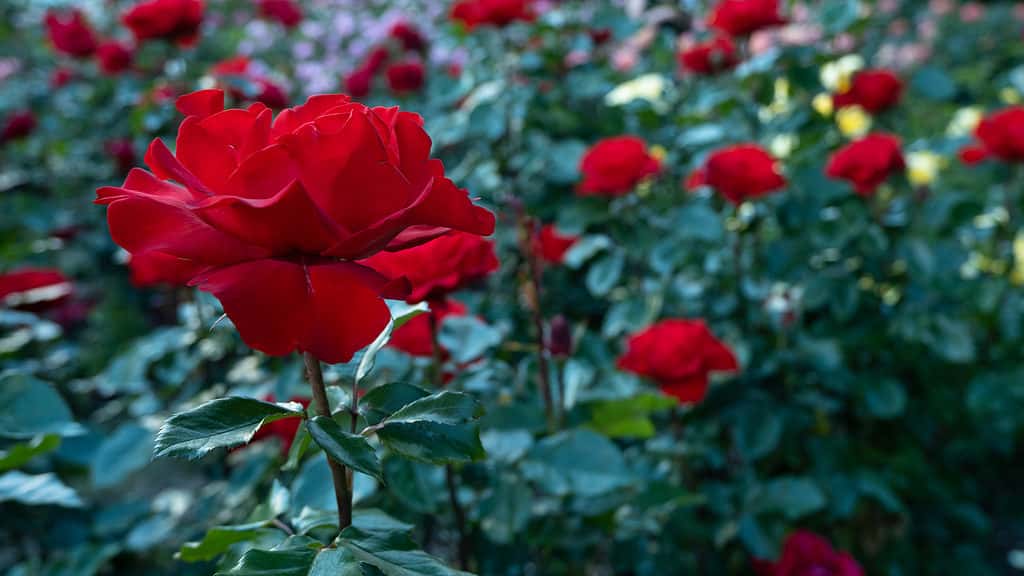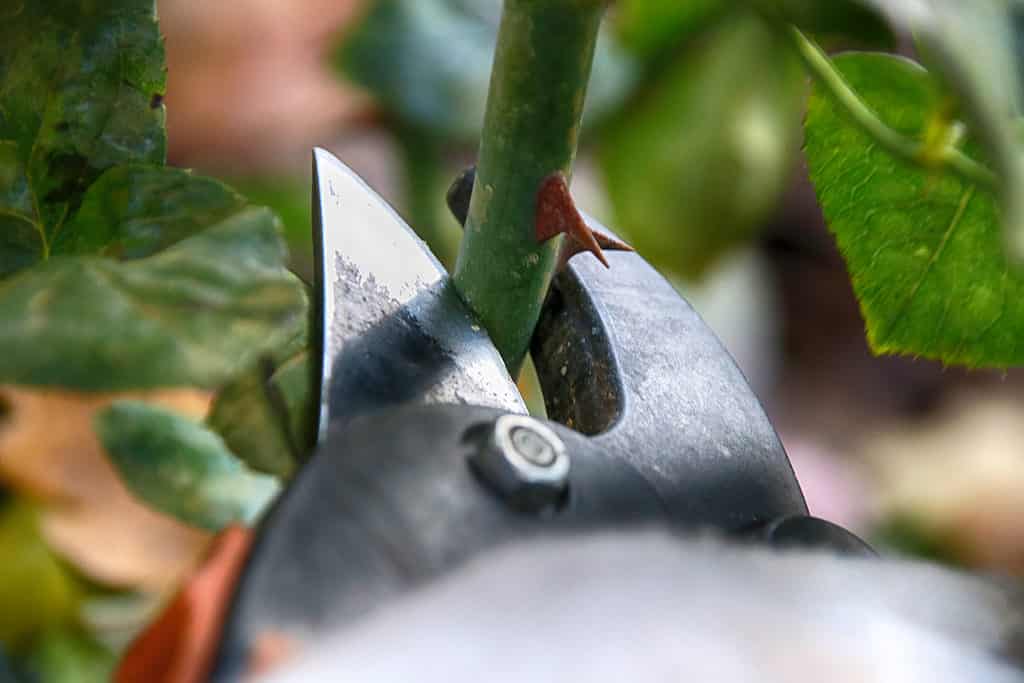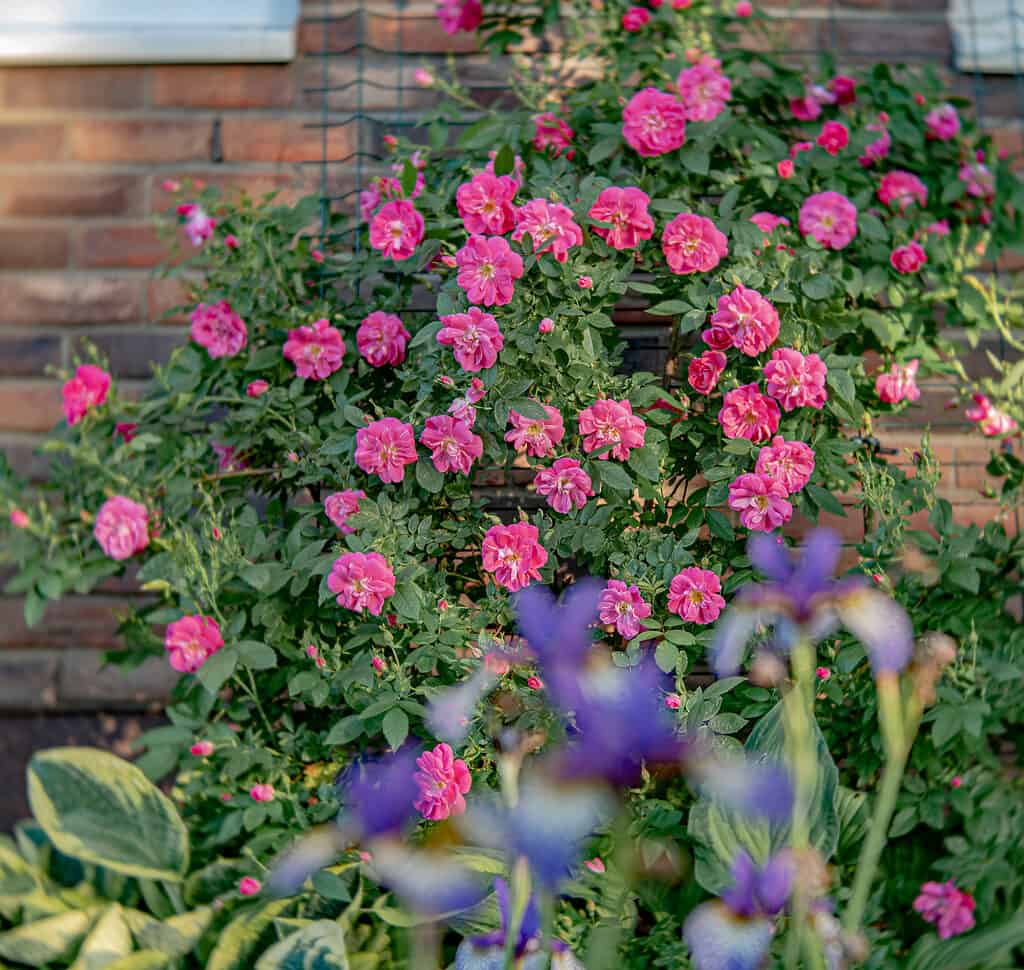Even novice gardeners may produce lovely results when they understand the fundamentals of trimming roses. Pruning is nothing to be afraid of! Most of the guidelines and cautions out there apply to those who produce roses as floral specimens or at exhibitions. For the everyday rose gardener who just wants lovely, healthy roses in their house or yard, there are only a handful of essential rules to follow.
We’ll teach you everything you need to know about trimming roses in this handy guide. From when to trim roses to trimming different varieties, you’ll get a good idea of how to properly trim and prune roses with ease.
When to Trim or Prune Roses
Rose bushes require regular pruning in order to encourage strong growth, preserve form, and produce an abundance of flowers. To ensure the effectiveness of this horticultural technique, timing is essential. The type of rose, the environment, and the local growth circumstances all influence the best time to trim rose bushes. Gardeners may optimize the advantages of pruning by making educated judgments by recognizing these factors.
In general, late winter or early spring, just before new growth starts, is the optimal time to trim rose bushes. The rose bushes are not actively developing during this time period, which is sometimes referred to as the dormant season. Pruning now enables the plant to concentrate its energy on spring’s healthy bloom development and new growth.
Specific Pruning Seasons
Depending on the environment, the precise period during the dormant season might change. Pruning can begin as early as January or February in areas with moderate winters. To prevent any potential harm to new growth in colder climes, it is advised to wait until the last frost has passed. Gardeners may choose the best time to prune their rose bushes by studying local weather trends and checking regional gardening information.
Rose varieties may require slightly varied trimming techniques. For example, hybrid tea roses benefit from more harsh pruning to promote strong growth and a profusion of blossoms. Shrub roses, on the other hand, which are often stronger and bushier, could need less trimming. It’s crucial to do your homework on the particular requirements of the rose type you’re growing to make sure you’re using the right pruning methods.
The proper equipment and methods must be used while trimming rose plants. To produce clean cuts and reduce the possibility of injury or the spread of illness, clean, sharp pruning shears or secateurs should be used. When pruning, the three Ds (dead, damaged, and diseased branches) should be the main emphasis because eliminating them improves plant health in general. Additionally, clearing away congested branches enhances airflow and lowers the danger of fungus infections.
The Dormant Period is Always Best
While modest pruning can be done at any time of the year to remove wasted flowers, promote repeat blooming, and preserve form, extensive pruning is often best done during the dormant season. Cutting slightly above a healthy leaf set or outward-facing bud removes fading flowers in this procedure, which is also known as deadheading. By preventing the rose bushes from using energy to create seeds, deadheading encourages them to produce more blooms.
The general rule that pruning should be done during the dormant season has several exceptions, it is important to note. In order to optimize the flowers of the following year, some climbers and ramblers may need to be pruned right away after blossoming. The same goes for roses that bloom on old wood; they should be clipped after flowering. To ensure that the proper timing and procedures are used, it is essential to understand the individual growth patterns and pruning requirements of each rose type.

©Salad Days/Shutterstock.com
Where to Trim or Prune Roses
Understanding the structure of rose bushes and the intent behind various pruning methods is essential when determining the precise spots for cutting. Gardeners can successfully shape their roses and promote healthy growth by understanding where exactly to trim them. Don’t worry; figuring out the right spot to cut is quite easy!
The stems, canes, and branches need to be pruned most often on rose bushes. It’s crucial to remember that based on the type of rose, its growth pattern, and the intended result, the specific areas for pruning cuts might change. However, there are some guidelines that might help gardeners in determining where to make pruning cuts.
Stem Pruning
The major branches that branch out from the main trunk of rose bushes are called stems. Just above a bud or leaf set that faces outward should be where pruning cuts are done on the stems. This encourages an open growth pattern and makes it possible for more air to circulate and sunshine to enter. Cutting at a 45-degree angle and sloping away from the bud promotes healing by preventing water buildup.
Cane Pruning
The bigger, woody branches of rose bushes are referred to as canes. To get rid of any diseased, damaged, or dead wood, canes need to be trimmed. It’s crucial to trim a cane back to a healthy outward-facing bud or lateral branch before completely eliminating it. This promotes new growth from the base and stops the growth of canes that are weak and crowded.
Branch Pruning
Smaller divisions of the main canes or stems are referred to as branches. Deadheading is the process of removing wasted blooms off branches when pruning them. Cutting slightly above a sound leaf set or bud, usually at a 45-degree angle, is the proper way to deadhead. The plant won’t waste energy on producing seeds thanks to this method, which encourages continual flowering.
Specific Pruning Needs for Specific Rose Varieties
In addition to these standard pruning areas, several rose varieties could have particular pruning needs. For example, hybrid tea roses thrive from rigorous pruning to encourage new growth and profusion of flowers. To do this, trim the canes to a height of 6 to 12 inches above the ground. On the other hand, pruning for shrub roses is usually just necessary to remove weak or dead wood.
Pruning requirements are different for climbing roses as well. Long, flexible canes that can be taught to climb trellises or other supports are often produced by these roses. When pruning climbing roses, it’s crucial to recognize and preserve the plant’s primary structure while eliminating only the older or weaker canes to promote new growth and flower production.
To keep rose bushes healthy and promote rapid development, you must know where to trim them. Knowing the many components of the plant, such as the stems, canes, and branches, makes it easier to pinpoint where pruning cuts should be made. Gardeners may shape their roses and encourage optimum development according to general rules, including trimming slightly above outward-facing buds or leaf sets. Pruning needs to take into account the unique requirements of each species of rose.

©photowind/Shutterstock.com
Understanding Different Rose Variety Pruning Needs
Depending on the variety and classification of your rose bush, different trimming guidelines must be followed. Before you prune, make sure you are aware of the specifics of the variety of your rose.
New Wood Blooms
The current season’s growth is when modern roses like hybrid tea, grandiflora, and floribundas bloom at their peak. Remove any old woody stems by rigorous pruning in the spring, about half to two-thirds of the plant’s height. Remove the central stems and any crossing branches from the remaining canes to form an open vase shape. To promote continued flowering, leave three to five healthy canes distributed around the plant in a variety of lengths.
Old Wood Blooms
Roses such as ramblers require pruning to get rid of winter damage and dead wood, as well as shaping to control their size. Ramblers only produce one bloom, and you may trim them right away, all the way back to two to three-inch canes if you choose. Don’t worry; you won’t lose any blooms the next season since they grow back very quickly.
Recurring Blooms
Shrub rose bushes like knockout roses are repeat bloomers that produce flowers on mature yet still young woody stems. After two years of not pruning to improve vigor, remove a third of the oldest canes along with those that are dead, sick, or dying.
Climbing roses also have the potential for recurrent bloom. Remove the dead wood and winter damage by pruning this shrub early. After flowering, trim the shrub once more to shape it and control its growth. As needed, get rid of lengthy canes that are worn out and feeble.

©LapaiIrKrapai/Shutterstock.com
How to Trim Roses Step by Step
You’ve probably realized at this point how important pruning or trimming is for roses. You can prune or trim your roses with success if you follow a step-by-step process and adhere to a few fundamental rules.
1. Get Your Tools and Equipment
Make sure you have the appropriate tools and equipment before beginning. Pruning secateurs or shears, loppers (for heavier branches), gloves, and safety goggles are required. To make clean cuts and stop the transmission of illnesses, make sure your instruments are clean, sharp, and in good condition.
2. Choose the Right Time
Before new growth starts is the best time to prune or trim rose bushes. This usually occurs in the late winter or early spring. The dormant season is another name for this time frame. Depending on your environment and the sort of roses you have, you should choose a precise time. Pruning should generally be done after the risk of frost has gone but before new buds begin to appear.
3. Evaluate Your Plant
Consider the state of your rose bushes for a minute before trimming. Determine any wood that is sick, damaged, or dead that has to be removed. To prevent airflow and sunlight penetration, look for branches that are crossed or packed together. Examine the plant’s overall size and shape since trimming can assist the plant retain and control the correct shape.
4. Remove Infected, Rotten, or Dead Wood
Remove any infected, damaged, or dead wood first. Use pruning shears or loppers to reduce these branches to healthy tissue. Make your cuts 14 inches above a healthy bud or leaf set at a 45-degree angle. This encourages new development and stops the spread of illnesses. Be mindful not to just chop the stem directly across.
5. Thin Out the Canes
Find any packed canes that fight for space and restrict ventilation. Choose the sturdiest or oldest canes, and cut them off at the base. For bigger canes, use loppers; for smaller canes, use pruning shears. Make an effort to design a balanced, open plant structure.
6. Shape Your Plant
Take into account the size and shape you want for your rose bush. You may shape it as you choose, depending on your rose variety. Popular forms include rounded, natural, or vase-shaped forms. To shape the remaining canes into the appropriate form, use pruning shears or loppers. You can get really creative at this stage!
7. Do Some Rejuvenation Pruning
You may choose rejuvenation pruning if your rose shrub is overgrown or weak. More severe pruning is used in this method to promote new growth and improve the health of the plant. Trim the entire plant back to a height of 12 to 18 inches. For specialized rose kinds like hybrid teas and floribundas, this technique is very helpful.
8. Clean Up Any Debris
Collect and clear the area of all the pruning waste. This aids in limiting the spread of pathogens and pests. Put the debris in a compost pile or simply throw it away.
9. Keep Up With Maintenance
Pruning is but one component of caring for roses. Continue with routine care procedures like watering, fertilizing, and disease control to guarantee optimum growth and health. Throughout the growing season, keep an eye on your roses, and deal with any problems right away.
You’ll be able to prune or trim your roses with confidence if you adhere to these detailed guidelines. Keep in mind that each rose variety may have different trimming requirements, therefore it’s crucial to learn about and understand what your particular roses require.
Rose-Trimming Tips
There are certain special ideas and practices that might help you get even better outcomes when trimming or pruning roses.
- Always use a clean, sharp blade to begin with. Blades that are dull or filthy might crush the stems, causing harm and sickness. To guarantee clean cuts, clean the blades before use and routinely sharpen them.
- It might also be helpful to seal the wounds when making bigger incisions on thicker canes or branches. This aids in limiting the spread of illnesses and pests. To seal the cut ends, use white glue or pruning sealer. Apply a thin coat over the cut to hide the wood that is showing.
- One should always prune slightly above an outward-facing bud or leaf set to promote an open growth habit and enhanced air circulation. This causes the new growth to develop outward, minimizing congestion in the plant’s core and lowering the danger of illness.
- Suckers, which are robust branches that emerge from below the graft union, are frequently produced by rose bushes. The rootstock gives rise to these suckers, which can sap the energy of the targeted rose variety. It’s critical to quickly locate and eliminate suckers. To stop them from growing again, cut them off as near to the base as you can.
As mentioned earlier, when using these special trimming suggestions, keep in mind the demands and features of your particular rose variety. Understanding the development patterns and requirements of each type of rose can help you make educated pruning decisions, as each rose variety may have unique characteristics. Happy trimming!
The post How To Trim Roses appeared first on AZ Animals.
from Animal News, Facts, Rankings, and More! - AZ Animals https://ift.tt/Ujq3Zzc